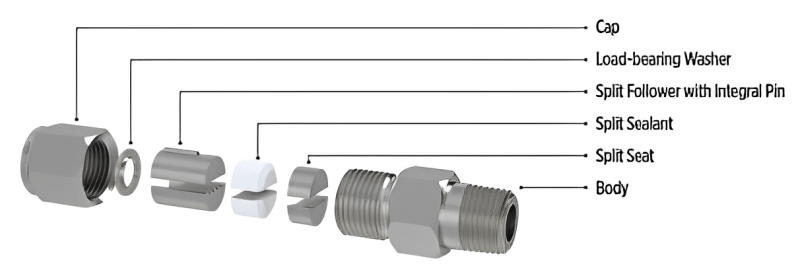In the intricate domain of plumbing and fluid systems, understanding compression fitting pressure ratings is paramount for ensuring system integrity and reliability. This comprehensive guide aims to demystify the nuances of compression fittings, shedding light on their pressure ratings and addressing a common concern: “How do I know if my compression fittings are tight enough?”
Compression Fittings: An Overview
Compression fittings consist of several crucial components, including the body, nut, and ferrule. The proper assembly of these elements ensures a leak-tight connection, vital for preventing fluid seepage and maintaining system efficiency.
Compression fittings, in their elegant simplicity, provide a leak-proof connection by compressing a ferrule or sleeve onto a pipe. This compression creates a tight seal, making these fittings invaluable in various industries, from plumbing to gas distribution.
Why Pressure Ratings Matter in Compression Fittings
Pressure ratings in compression fittings denote the maximum allowable pressure that the fitting can handle. It’s a crucial piece of information that ensures the fitting operates within its designed parameters, preventing leaks, bursts, and potential hazards.
The stakes are high in fluid systems, and pressure ratings act as guardians of system integrity. Understanding and adhering to these ratings prevent catastrophic failures, ensuring that the compression fittings operate seamlessly under the expected pressures.
Factors Influencing Compression Fitting Pressure Ratings
The pressure rating of a compression fitting refers to the maximum working pressure it can withstand without compromising its integrity. This rating is a crucial factor in determining the fitting’s suitability for specific applications.
1. Material Composition
The material from which a compression fitting is crafted plays a pivotal role in determining its pressure rating. Different materials exhibit varying levels of resilience to pressure, and understanding these characteristics is fundamental to selecting the right fitting for a specific application.
2. Design and Construction Features
The intricacies of design, such as the structure of the ferrule and the overall construction of the compression fitting, contribute to its pressure-handling capabilities. Factors like the number of compression points and the overall robustness of the design influence the fitting’s performance under pressure.
How to Verify Compression Fitting Tightness: Simple Techniques for Assurance
1. Hand-Tightening
Start by hand-tightening the nut onto the fitting, ensuring a snug fit. Once hand-tight, use the appropriate wrench to make a quarter to a half turn to secure the fitting further. Do not overtighten as this can cause harm.
2. Gap Inspection
After tightening, inspect the gap between the nut and the body. A uniform and minimal gap indicates proper compression, ensuring a leak-tight seal. If the gap is too wide or uneven, further tightening may be necessary.
3. Leak Testing
Perform a leak test after installation. Apply system pressure and inspect the fitting for any signs of leakage. If leaks are detected, reevaluate the tightness of the compression fitting and make necessary adjustments.
Conclusion: Ensuring System Reliability
In the intricate dance of fluid systems, compression fittings are the choreographers, ensuring a seamless and leak-free performance. Navigating the world of compression fitting pressure ratings is not just a technical exercise; it’s a commitment to the safety and longevity of the entire system. As we unravel the significance of these ratings, we empower ourselves to make informed decisions, ensuring that every compression fitting plays its part in the symphony of fluid dynamics.
Post time: Dec-22-2023


